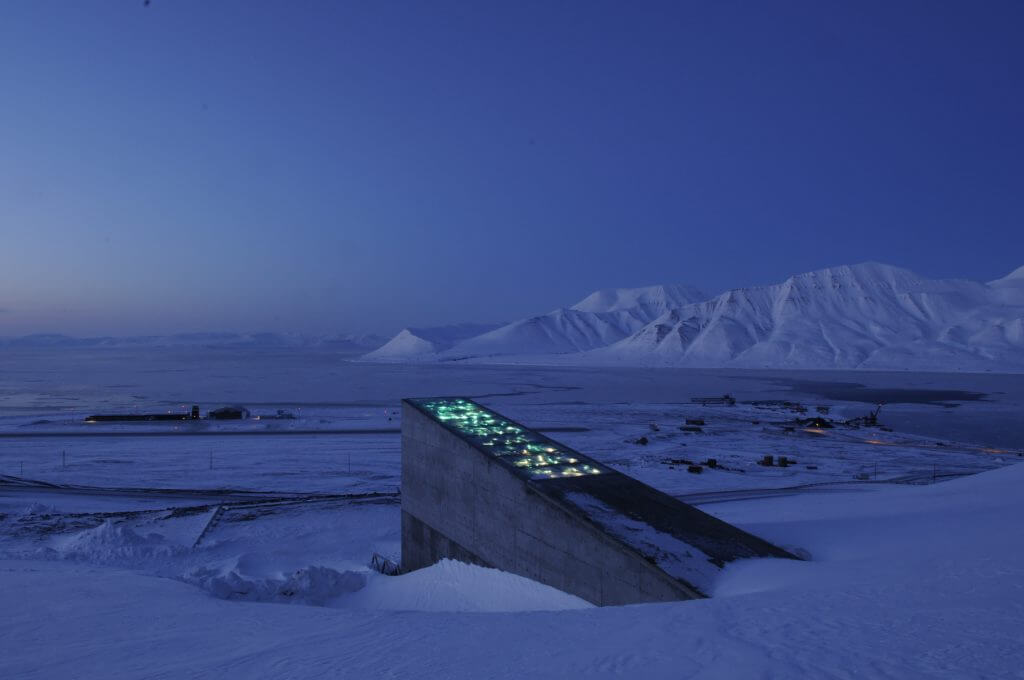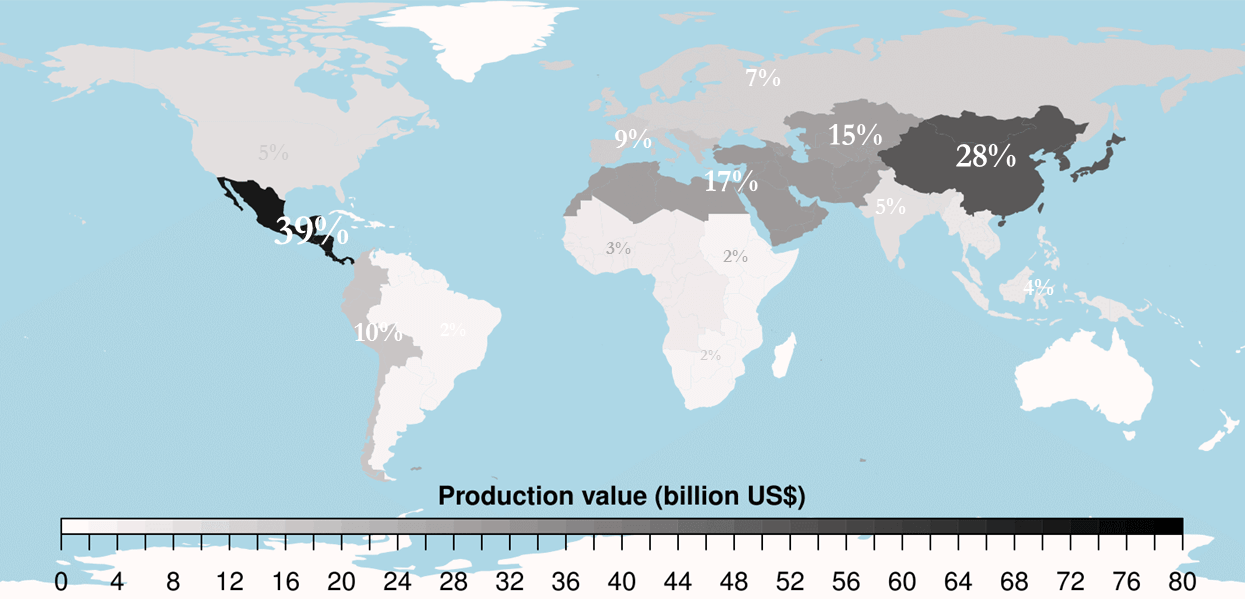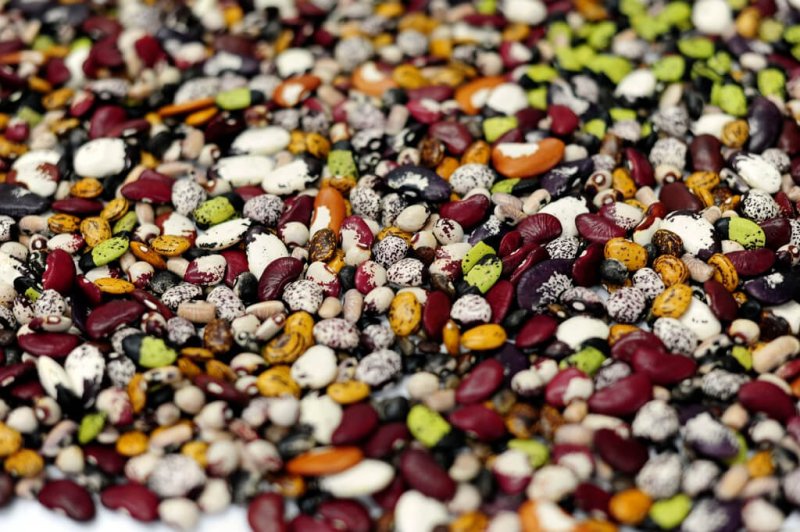Here’s the argument: Genetic diversity in food plants is an essential resource needed to keep crops productive, nutritious, resistant to pests and diseases, and tolerant to drought, heat, and other climatic challenges. Farmers need these traits to produce good yields, and plant breeders provide them by mixing and matching the genetic diversity found within the seeds of modern cultivars, ancient heirlooms, and even wild relatives to produce vigorous new crop varieties.
So where do plant breeders find these seeds? Here’s where we get to international collaboration. Crop genetic diversity increases with time: The places where food crops have been continuously cultivated for hundreds to thousands of years, and especially where they were initially domesticated many thousands of years ago, tend to be extraordinarily diverse.

Wheat, corn, rice and every other one of the crops that feed us originated and diversified in distinct regions around the world. Now they are grown just about everywhere. From Canada to Argentina, Mexico to Mongolia, varieties of these crops have been introduced and adapted to different climates and soils, pests and diseases. This work never ends—it’s a continuous process of breeding and adaptation to maintain agricultural productivity. To support this most important of endeavors, we all have a stake in the open exchange of seeds.
But just how interdependent are countries with regard to seeds?
In its 15 years of existence, the Seed Treaty has made some progress toward its goals. Its 143 member countries have negotiated a way by which crop seeds in the public domain can more easily be shared across borders. They have also started to keep track of these seeds, better ensuring that they remain public, and have built a benefit-sharing fund that has disbursed $20 million in support of crop diversity conservation and capacity building worldwide. Related initiatives focus on providing long-term financial support to the world’s most diverse and vulnerable public genebanks, where substantial crop genetic diversity is maintained, and offer a global safety backup for seeds in the Arctic.

But much remains to be done to adequately share and care for the world’s seeds. A number of countries have yet to join the treaty, and implementation of its procedures by many members has been slow. Essential components such as the affirmation of the rights of farmers to continue their traditional seed exchange practices, and the contributions to the conservation fund, need strengthening.
Surely it’s partly a matter of time; big political processes move at glacial speed. But I suspect that roadblocks persist because of a deeper problem: the central argument that we all benefit from one another’s seeds hasn’t had enough teeth to motivate comprehensive political action.
Unfortunately, complete data on the extent to which countries give and receive seeds aren’t available. Tracking these exchanges was mandated only recently, and we won’t know the results until some years in the future. By then we’ll be even further behind on the urgent work needed to adapt crops to climate change.
How about an estimate of interdependence among countries?
Returning to the roots of the argument for the creation of the Seed Treaty, our research team has estimated the degree to which countries depend on one another’s seeds. The calculation was based on the proportion of each country’s national agricultural production, and its food supply, that is composed of crops whose origins, or “primary regions of diversity” are found elsewhere around the world.
We found that countries indeed produce and consume crops from many different primary regions of diversity. The US, for example, grows crops like corn and cotton that originated in Central America, wheat and alfalfa from West Asia, soybeans and citrus from East Asia, and other crops originating in the Mediterranean, Europe, Southeast Asia, South Asia, Andean South America, East Africa, and other regions. A bit of what we grow originated in North America itself, but not a lot. It’s very much the same story for the food we eat.

To put simpler numbers on the trend, we estimated the degree to which each country cultivates or eats “foreign” crops, defined as plants whose primary regions of diversity do not overlap at all with the region where the country is located. For the US, we found that more than 95% of American agricultural production is of foreign crops, as is at least 90% of its food supply.
Averaging across all countries, about 70% of crops grown, and 69% of plants consumed, are immigrants. No country produces or consumes only native foods. Countries are increasingly cultivating and eating foreign crops as economic development proceeds and as food systems become more globalized.
Interdependence and the state of the Seed Treaty
Even with a lack of comprehensive data on consumption and production and crop diversity regions, it is clear that people in all countries grow and eat food crops whose genetic diversity is largely concentrated outside their borders, and would therefore benefit from the facilitated exchange of agricultural seeds. The very likely trend is for increasing needs for seeds, as markets adapt to changing consumer preferences and as producers adapt to increasingly challenging environmental conditions.
The evidence on countries’ predominant use of foreign crops bolsters the rationale for strengthening international collaboration on conservation of crop diversity and for making the exchange of all agricultural seeds as easy and affordable as possible. Our interdependence also boosts the argument for considering the genetic diversity of globally important food crops as public goods which should be openly available to all, and for respecting the rights of farmers to practice their traditional methods of conservation and exchange, not only in recognition of their historical contributions to the diversity in our food, but also in active support of its further evolution.
The Seed Treaty has already done a lot to formalize the understanding that it is prudent for countries to collaborate on sharing and caring for seeds. As one of the world’s agricultural powerhouses, and still the single largest public provider of crop diversity, the US ratification of the Treaty is exciting. Hopefully this is a key moment in the progress toward a truly global agreement where countries work together to conserve and share the diversity of the crops that nourish us all.
A version of this article previously appeared on the GLP on June 21, 2017, after being originally published on the Union of Concerned Scientist’s website as “We All Benefit from Foreign Nations’ Food Crop Diversity—But Do Our Politics Reflect This Interdependence?”
Colin Khoury studies diversity in the crops people grow and eat worldwide, and the implications of change in this diversity on human health and environmental sustainability. He is particularly interested in the wild relatives of crops. Colin is a research scientist at the International Center for Tropical Agriculture (CIAT), Colombia, and at the USDA National Laboratory for Genetic Resources Preservation in Fort Collins, Colorado. Follow him on Twitter @ColinKhoury































